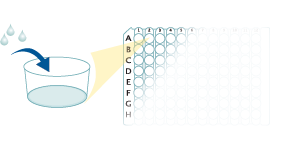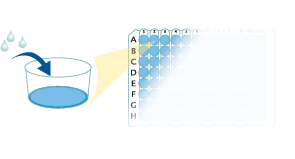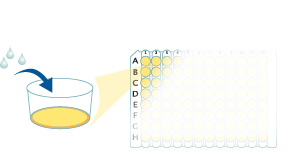Human Glypican 3 Quantikine ELISA Kit Summary
Product Summary
Precision
Cell Culture Supernates, Cell Lysates, Serum, EDTA Plasma, Heparin Plasma
| Intra-Assay Precision | Inter-Assay Precision | |||||
|---|---|---|---|---|---|---|
| Sample | 1 | 2 | 3 | 1 | 2 | 3 |
| n | 20 | 20 | 20 | 20 | 20 | 20 |
| Mean (pg/mL) | 412 | 1208 | 2387 | 466 | 1231 | 2359 |
| Standard Deviation | 12 | 48 | 79.6 | 38.4 | 75.3 | 143 |
| CV% | 2.9 | 4 | 3.3 | 8.2 | 6.1 | 6.1 |
Recovery
The recovery of human Glypican 3 spiked to levels throughout the range of the assay in various matrices was evaluated.
| Sample Type | Average % Recovery | Range % |
|---|---|---|
| Cell Culture Media (n=4) | 99 | 88-112 |
| EDTA Plasma (n=4) | 88 | 81-95 |
| Heparin Plasma (n=4) | 89 | 81-96 |
| Serum (n=4) | 89 | 82-97 |
Linearity
Scientific Data
Preparation and Storage
Background: Glypican 3
The glypicans (GPC) constitute a family of glycosylphosphatidylinositol (GPI)-anchored, heparan sulfate proteoglycans. Six members of this family have been identified in mammals (GPC1-GPC6). All glypican core proteins contain an N-terminal signal peptide, a large globular cysteine-rich domain (CRD) with 14 invariant cysteine residues, a stalk-like region containing the heparan sulfate attachment sites, and a C-terminal GPI attachment site.
Mutations in Glypican 3 cause a rare disorder in humans, Simpson-Golabi-Behmel Syndrome, which is characterized by pre- and postnatal overgrowth of multiple tissues and organs and an increased risk for developing embryonic tumors. These features are also present in the mouse knock-out of Glypican 3 indicating that Glypican 3 regulates cell survival and inhibits cell proliferation during development. Glypican 3 has been implicated in regulating many different signaling pathways including: IGF, FGF, BMP and Wnt. An endoproteolytic processing of Glypican 3 by proprotein convertases is required for the modulation of Wnt signaling. Direct interaction of Glypican 3 with FGF-basic has been observed and is mediated by the heparan sulfate chains.
Assay Procedure
Refer to the product- Prepare all reagents, standard dilutions, and samples as directed in the product insert.
- Remove excess microplate strips from the plate frame, return them to the foil pouch containing the desiccant pack, and reseal.
- Add 100 µL of Assay Diluent to each well.
- Add 100 µL of Standard, control, or sample to each well. Cover with a plate sealer, and incubate at room temperature for 2 hours on a horizontal orbital microplate shaker.
- Aspirate each well and wash, repeating the process 3 times for a total of 4 washes.
- Add 200 µL of Conjugate to each well. Cover with a new plate sealer, and incubate at room temperature for 2 hours on the shaker.
- Aspirate and wash 4 times.
- Add 200 µL Substrate Solution to each well. Incubate at room temperature for 30 minutes on the benchtop. PROTECT FROM LIGHT.
- Add 50 µL of Stop Solution to each well. Read at 450 nm within 30 minutes. Set wavelength correction to 540 nm or 570 nm.





Citation for Human Glypican 3 Quantikine ELISA Kit
R&D Systems personnel manually curate a database that contains references using R&D Systems products. The data collected includes not only links to publications in PubMed, but also provides information about sample types, species, and experimental conditions.
1 Citation: Showing 1 - 1
-
Development of an Affimer-antibody combined immunological diagnosis kit for glypican-3
Authors: C Xie, C Tiede, X Zhang, C Wang, Z Li, X Xu, MJ McPherson, DC Tomlinson, W Xu
Sci Rep, 2017-08-29;7(1):9608.
Species: Human
Sample Types: Serum
FAQs
-
Which isoform(s) does R&D Systems Human Glypican 3 Quantikine ELISA kit (Catalog DGLY30) detect?
The Human Glypican 3 Quantikine ELISA Kit is designed to detect Human Glypican 3 isoform 1, and we have confirmed this in-house. It is possible that the assay also detects other Human Glypican 3 isoforms, however, R&D Systems has not performed this evaluation.
Reviews for Human Glypican 3 Quantikine ELISA Kit
Average Rating: 5 (Based on 1 Review)
Have you used Human Glypican 3 Quantikine ELISA Kit?
Submit a review and receive an Amazon gift card.
$25/€18/£15/$25CAN/¥75 Yuan/¥1250 Yen for a review with an image
$10/€7/£6/$10 CAD/¥70 Yuan/¥1110 Yen for a review without an image
Filter by:
Transfect the hGPC3 on HEK cells and collect the supernatant and measured. Crystal Clear.







